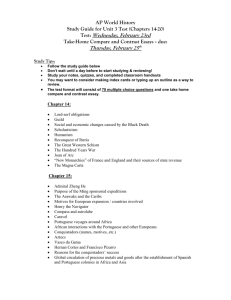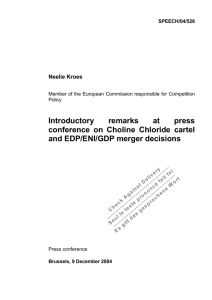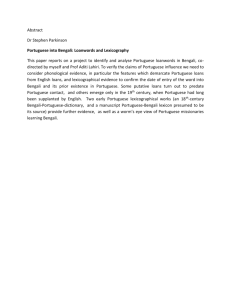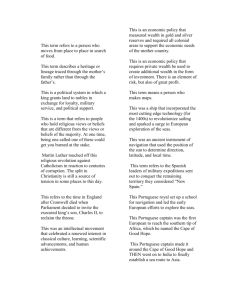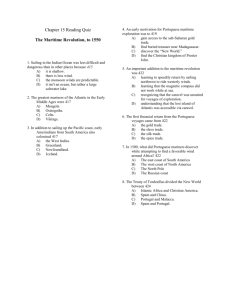Bonhomme Richard SO482 The Portuguese Seaborne Empire
advertisement
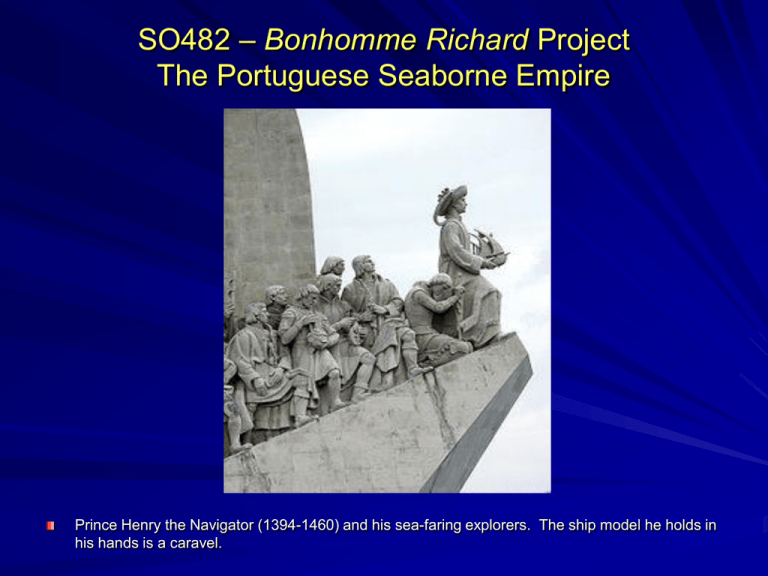
SO482 – Bonhomme Richard Project The Portuguese Seaborne Empire Prince Henry the Navigator (1394-1460) and his sea-faring explorers. The ship model he holds in his hands is a caravel. SO482 – Bonhomme Richard Project The Portuguese Seaborne Empire Early Portuguese voyages along the coast of West Africa. From 1440 to 1460, more than 80 caravels set sail into the South Atlantic. SO482 – Bonhomme Richard Project The Portuguese Seaborne Empire The voyage of Bartholomeu Dias, during which he became the first Westerner to round the Cape of Good Hope. His squadron consisted of two caravels and a square-rigged support ship. SO482 – Bonhomme Richard Project The Portuguese Seaborne Empire Another view of Bartolomeu Dias’ voyage past the southern tip of Africa – and back! - in 1487. SO482 – Bonhomme Richard Project The Portuguese Seaborne Empire The route taken by Vasco da Gama on his first voyage to India in 1497-98. SO482 – Bonhomme Richard Project The Portuguese Seaborne Empire Da Gama’s path to India. SO482 – Bonhomme Richard Project The Portuguese Seaborne Empire Drawing of a 3-masted caravel from a book published in 1516. Compared to the relatively massive carracks, the low profile and shallow draft of caravels reduced windage/leeway – a major consideration when sailing in contrary currents and winds. SO482 – Bonhomme Richard Project The Portuguese Seaborne Empire A contemporary 15th-century sculpture illustrates a remarkable advance in ship design – the foreand-aft rigged caravel. SO482 – Bonhomme Richard Project The Portuguese Seaborne Empire Compass rose. With their fore-and-aft rig, caravels could point to within four or four and a half points (45-50 degrees) to the wind – a considerable improvement over square-rigged vessels (shown in green). SO482 – Bonhomme Richard Project The Portuguese Seaborne Empire Currents encountered by Dias in his voyage of discovery past the tip of Africa in 1487. His success was made possible in part by his use of caravels that could point higher to the wind than square-rigged carracks with their high sides and towering castles fore and aft. SO482 – Bonhomme Richard Project The Portuguese Seaborne Empire The Portuguese trading empire in the 16th century. The principal outposts were in Goa (India), Malacca (East Indies), Macau (China), and Nagasaki (Japan). SO482 – Bonhomme Richard Project The Portuguese Seaborne Empire Jan van Linschoten. In 1596 he published a journal of his travels in the Portuguese East, including India and Mozambique. His account of this exotic land “aroused the envious greed of the rest of Europe.” SO482 – Bonhomme Richard Project The Portuguese Seaborne Empire In the picture to the left, a Portuguese merchant’s family is waited on literally hand and foot by native servants at Hormuz. The scene to the left depicts Portuguese gentlemen in Goa, India, attended by slaves. Linschoten wrote of them, “They step forward with a great pride and vainglorious majesty, with a slave to keep the sun and rain from them.” SO482 – Bonhomme Richard Project The Portuguese Seaborne Empire Although hard to believe, nearly all these 15th and 16th-century voyages of discovery – even those of Columbus – had but one goal in mind: to find a sea-borne route to the Orient. NB: Cano’s and de [sic] Gama’s colors are reversed.


